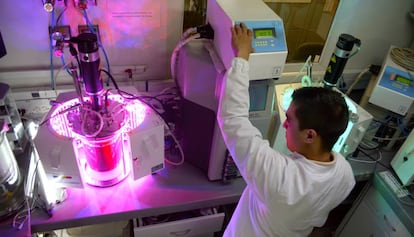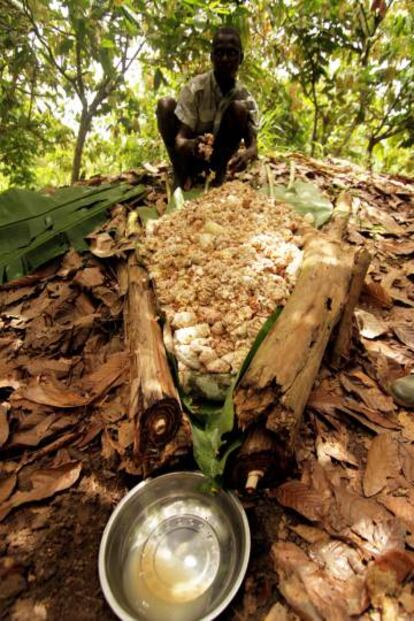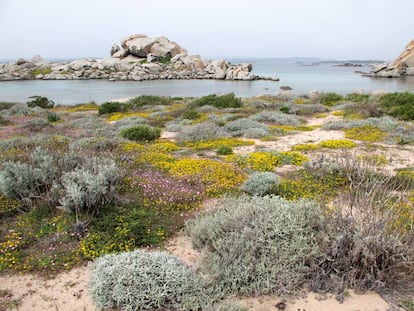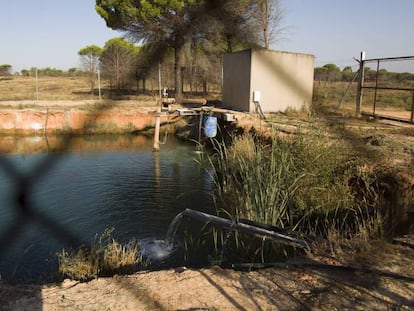Can scientists save us from a world without chocolate?
Researchers are finding new ways of producing food inside test tubes – but will it taste the same?

A world without chocolate. Such is the apocalyptic future described by some observers of climate change. But scientists are racing to find solutions, and the good news is that laboratory-made chocolate is already at the prototype stage.
The temperature rise of 2.5ºC expected by 2050 will make cocoa cultivation impossible across most of the land currently used for this crop, according to a study by the International Center for Tropical Agriculture that focuses on Ghana and Ivory Coast.
By 2030, when temperatures go up by 1ºC, production will already be significantly lower, and chocolate will begin to be considered a luxury item.
It remains to be seen whether this food will be accepted by consumers
Miguel Ángel Lurueña, food technology expert
It was this doom-and-gloom scenario that prompted Lucía Atehortua, who coordinates the Biotechnology Group at Antioquia University, in Colombia, to start researching alternatives to ensure that humankind is not left without a product “that is healthy and in high global demand.”
The idea was to create cocoa inside a lab. But how? The simplified explanation is that a cocoa seed is taken and some of its tissues isolated – specifically, those that are in constant reproduction. These are placed in a liquid medium containing a cocktail of nutrients that include nitrogen, phosphorus, iron, boron, magnesium, copper, essential amino acids and vitamins.

These and other substances that stimulate cell separation, combined with doses of oxygen, light and carbon dioxide, lead to massive multiplication. After about a month, the mix is transferred to a bioreactor, and exposed to a new set of light and temperature combinations in order to extract the biomass, polyphenols and fatty acids that go into making the chocolate that we all know.
But does it taste like real chocolate? Atehortua’s reply is, not for now, no. That is because their product does not undergo the fermentation applied in industrial processes – but they are working on that.
Her lab is also working on other innovative projects such as cloning thaumatin, a protein around 2,500 times sweeter than sugar that would make it possible to obtain sweet, calorie-free cocoa.
But for now, the main challenge is how to produce lab chocolate on an industrial scale that would bring its cost down to something more similar to the cost of producing regular chocolate.
“And you also need to check the water and carbon footprints to see if it is environmentally sustainable,” adds the biologist. “These tests have not been conducted yet, so we don’t know if this will become a reality.”
It is necessary to seek alternatives to traditional production in order to deal with the consequences of climate change
Be that as it may, the concept of lab food is not just a pipe dream. Miguel Ángel Lurueña, a specialist in food technology and author of the blog Gominolas de petróleo, says that it is becoming an increasingly realistic option to overcome certain problems inherent to traditional production, such as the need for enormous investments in plants, water, manpower, time and processing equipment. And there is also an ethical component when it comes to meat production, for instance.
“It remains to be seen to what extent this type of food is similar to conventionally produced food, and above all, whether it will be accepted by consumers, and not just because of the food’s organoleptic properties, but because of people’s prejudices – such as fears and disdain – and prices,” he says.
Ana Ríos, an expert on climate change at the Inter-American Development Bank (BID), says that higher temperatures will bring more drought in future, compromising many crops that are essential to humans, such as potatoes and wheat. A BID-sponsored project has conducted an in vitro analysis of both to discover which varieties would be better suited to the new weather conditions.
Goodbye, coffee
Something similar is happening with coffee, given that the Coffea plant will have to be grown at higher altitudes as temperatures rise. At one point, there will probably no longer be enough land to meet global demand. “Today, the appropriate elevation is around 1,200 meters; in 2020 in will be 1,400 meters and in 2050 it will be 1,600 meters,” says Ríos.
The picture that emerges is that it is necessary to seek alternatives to traditional production in order to deal with the consequences of climate change – whether inside a lab, with the genetic cut-and-paste technology of CRISPR, or through genomic studies of crops to find those that will better adapt to the climate of the future.
English version by Susana Urra.
Tu suscripción se está usando en otro dispositivo
¿Quieres añadir otro usuario a tu suscripción?
Si continúas leyendo en este dispositivo, no se podrá leer en el otro.
FlechaTu suscripción se está usando en otro dispositivo y solo puedes acceder a EL PAÍS desde un dispositivo a la vez.
Si quieres compartir tu cuenta, cambia tu suscripción a la modalidad Premium, así podrás añadir otro usuario. Cada uno accederá con su propia cuenta de email, lo que os permitirá personalizar vuestra experiencia en EL PAÍS.
¿Tienes una suscripción de empresa? Accede aquí para contratar más cuentas.
En el caso de no saber quién está usando tu cuenta, te recomendamos cambiar tu contraseña aquí.
Si decides continuar compartiendo tu cuenta, este mensaje se mostrará en tu dispositivo y en el de la otra persona que está usando tu cuenta de forma indefinida, afectando a tu experiencia de lectura. Puedes consultar aquí los términos y condiciones de la suscripción digital.
More information
Archived In
Últimas noticias
Most viewed
- Reinhard Genzel, Nobel laureate in physics: ‘One-minute videos will never give you the truth’
- Oona Chaplin: ‘I told James Cameron that I was living in a treehouse and starting a permaculture project with a friend’
- Pablo Escobar’s hippos: A serious environmental problem, 40 years on
- Why we lost the habit of sleeping in two segments and how that changed our sense of time
- Chevy Chase, the beloved comedian who was a monster off camera: ‘Not everyone hated him, just the people who’ve worked with him’











































